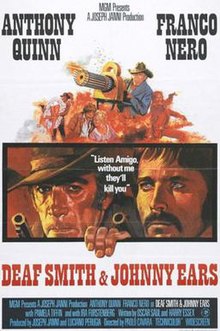
The spaghetti Western is a broad subgenre of Western films produced in Europe. It emerged in the mid-1960s in the wake of Sergio Leone's filmmaking style and international box-office success. The term was used by foreign critics because most of these Westerns were produced and directed by Italians.

Ace High is a 1968 Italian Spaghetti Western film directed and written by Giuseppe Colizzi and starring Terence Hill, Bud Spencer and Eli Wallach. The film is the second in a trilogy that started with God Forgives... I Don't! and ended with Boot Hill.

His Name Was King is a 1971 Italian Western film directed by Giancarlo Romitelli and starring Richard Harrison and Klaus Kinski.

Shoot the Living and Pray for the Dead is the original release title of the 1971 Italian dramatic Spaghetti Western film directed by Giuseppe Vari, and starring Klaus Kinski and Dante Maggio. With its many international releases, the film had additional English titles of Pray to Kill and Return Alive, To Kill a Jackal, and Renegade Gun. The script by Adriano Bolzoni is inspired by American noir-crime films of the 1930s and 1940s, and Kinski's entry into the scene reprises Edward G. Robinson's presence in Key Largo (1948).

Black Killer is a 1971 Italian Spaghetti Western film directed by Carlo Croccolo and starring Klaus Kinski.

The Deserter, also known as The S.O.B.s and The Devil's Backbone is a 1970 Italian-Yugoslav American international co-production Western film produced by Dino De Laurentiis. It was directed by Burt Kennedy and written by Clair Huffaker.
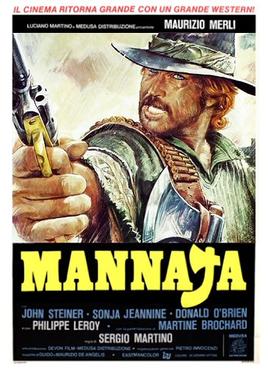
Mannaja is an Italian 1977 spaghetti Western film directed by Sergio Martino. The main role, Blade, is played by Maurizio Merli. Other central roles are played by John Steiner, Sonja Jeannine, Donald O'Brien, Philippe Leroy and Martine Brochard.
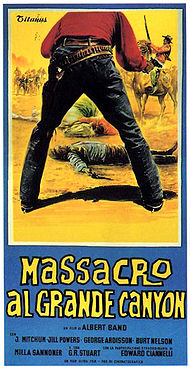
Grand Canyon Massacre is a 1964 Italian Spaghetti Western filmed in Croatia starring James Mitchum, Milla Sannoner, and George Ardisson. It was directed by Sergio Corbucci and produced by Albert Band. The film's theme song was performed by Rod Dana. The film has nothing to do with the Grand Canyon.
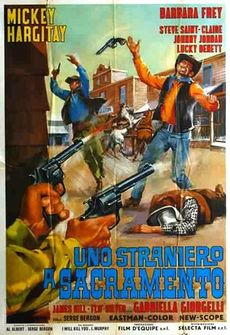
Stranger in Sacramento or Uno straniero a Sacramento is a 1965 Italian Spaghetti Western film directed by Sergio Bergonzelli. It was based on the novel I Will Kill You Tomorrow by Jim Murphy.

A Reason to Live, a Reason to Die is a 1972 Technicolor Italian spaghetti Western movie starring James Coburn, Bud Spencer, and Telly Savalas.

Requiescant is a 1967 Spaghetti Western film directed by Carlo Lizzani and starring Lou Castel, Mark Damon, Barbara Frey and Pier Paolo Pasolini, in one of his few acting roles.
Paolo Cavara was an Italian screenwriter and film director. He is best known for collaborating with Gualtiero Jacopetti and Franco E. Prosperi on the 1962 mondo film Mondo Cane, and for directing the fiction film The Wild Eye (1967) and two giallo films, Black Belly of the Tarantula (1971) and Plot of Fear (1976).

Sugar Colt is a 1966 Italian and Spanish spaghetti Western directed by Franco Giraldi, produced by Franco Cittadini and Stenio Fiorentini, written by Sandro Continenza, Augusto Finocchi, Giuseppe Mangione and Fernando Di Leo, composed by Luis Enríquez Bacalov, filmed by Alejandro Ulloa and starred by Jack Betts, Joaquín Parra, Soledad Miranda, Georges Rigaud, Antonio Padilla, Giuliano Raffaelli and Hunt Powers. It is the Giraldi's second film after Seven Guns for the MacGregors. The film represents the cinematographical debut for Jack Betts, here credited as Hunt Powers, and it is also Erno Crisa's last film.

A Bullet for Sandoval is a 1969 Spaghetti Western film. It is a co-production between Italy and Spain. The film was generally well received by critics. For years, it was thought that famed Italian horror film director Lucio Fulci directed this western, but that was later disputed by the film's lead star George Hilton.
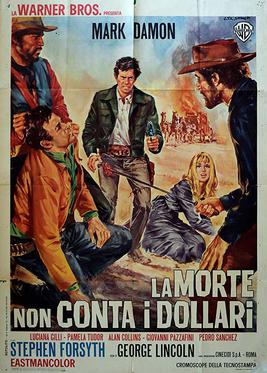
La morte non conta i dollari 1967 Italian spaghetti Western film directed by Riccardo Freda. The film is about Lawrence White who returns to his hometown of Owell Rock with his sister to avenge the father's death at the hands of a gang. The leader of the gang, Doc Lester has recently appointed himself the gunslinger Boyd as the new sheriff.
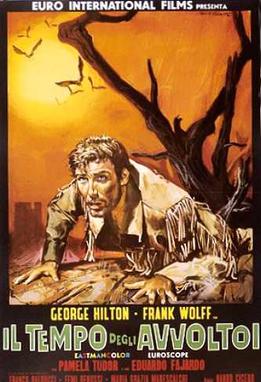
Il tempo degli avvoltoi is a 1967 Italian spaghetti Western film directed by Nando Cicero.
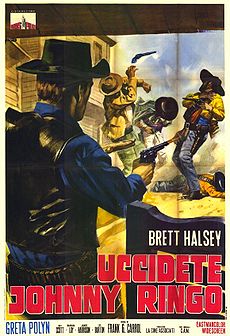
Uccidete Johnny Ringo, internationally released as Kill Johnny Ringo, is a 1966 Italian western film directed by Gianfranco Baldanello. It is the film debut in the Spaghetti Western genre for Brett Halsey.

Django Shoots First is an Italian Spaghetti Western film directed by Alberto De Martino.

Per il gusto di uccidere is the 1966 Italian Spaghetti Western film debut directed by Tonino Valerii. It is also the first film to use the camera system known as 2P. It was filmed in Almería. It is produced by Francesco Genesi, Vincenzo Genesi, Daniele Senatore, Stefano Melpignano and Jose Lopez Moreno, scored by Nico Massi and edited by Rosa G. Salgado.

The Belle Starr Story/Il mio corpo per un poker is a 1968 Italian made episodic Bonnie and Clyde type Spaghetti Western co-written and co-directed by Lina Wertmüller and starring Elsa Martinelli who also sings the title song. It is the only Spaghetti Western directed by a woman and one of the few which stars a woman in the title role. Wertmüller replaced after a few days Piero Cristofani, who was at his directorial debut.
